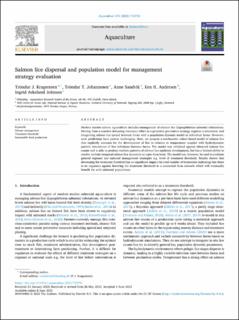| dc.contributor.author | Kragesteen, Tróndur J. | |
| dc.contributor.author | Johannesen, Tróndur T. | |
| dc.contributor.author | Sandvik, Anne Dagrun | |
| dc.contributor.author | Andersen, Ken H. | |
| dc.contributor.author | Johnsen, Ingrid Askeland | |
| dc.date.accessioned | 2023-11-21T13:30:00Z | |
| dc.date.available | 2023-11-21T13:30:00Z | |
| dc.date.created | 2023-06-26T10:21:14Z | |
| dc.date.issued | 2023 | |
| dc.identifier.citation | Aquaculture. 2023, 575 . | |
| dc.identifier.issn | 0044-8486 | |
| dc.identifier.uri | https://hdl.handle.net/11250/3103871 | |
| dc.description.abstract | Modern marine salmon aquaculture includes management of salmon lice (Lepeophtheirus salmonis) infestations. Moving from a reactive delousing treatment effort to a proactive preventive strategy requires a simulation tool integrating salmon lice spread between farms with a population dynamic model at individual farms. However, such predictions have proven challenging. Here, we propose a mechanistic cohort-based model of salmon lice that explicitly accounts for the development of lice in relation to temperature coupled with hydrodynamic particle simulations of lice infections between farms. The model was validated against observed salmon lice counts and is able to produce realistic patterns of salmon lice epidemic development, but has a limited ability to resolve realistic temporal salmon lice dynamics on a per-farm basis. The model can, however, be used to evaluate general regional and national management strategies e.g. level of treatment threshold. Results shown that decreasing the treatment threshold has no significant impact the total number of treatments indicating that there is no argument against lowering the treatment threshold in a connected farm network which will eventually benefit the wild salmonid populations. | |
| dc.language.iso | eng | |
| dc.title | Salmon lice dispersal and population model for management strategy evaluation | |
| dc.title.alternative | Salmon lice dispersal and population model for management strategy evaluation | |
| dc.type | Peer reviewed | |
| dc.type | Journal article | |
| dc.description.version | publishedVersion | |
| dc.source.pagenumber | 16 | |
| dc.source.volume | 575 | |
| dc.source.journal | Aquaculture | |
| dc.identifier.doi | 10.1016/j.aquaculture.2023.739759 | |
| dc.identifier.cristin | 2157844 | |
| dc.relation.project | Havforskningsinstituttet: 15696 | |
| cristin.ispublished | true | |
| cristin.fulltext | original | |
| cristin.qualitycode | 2 | |
